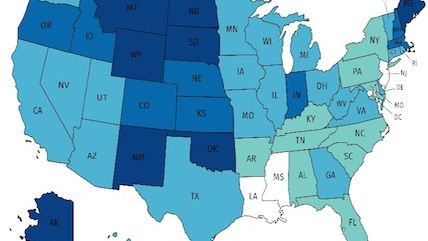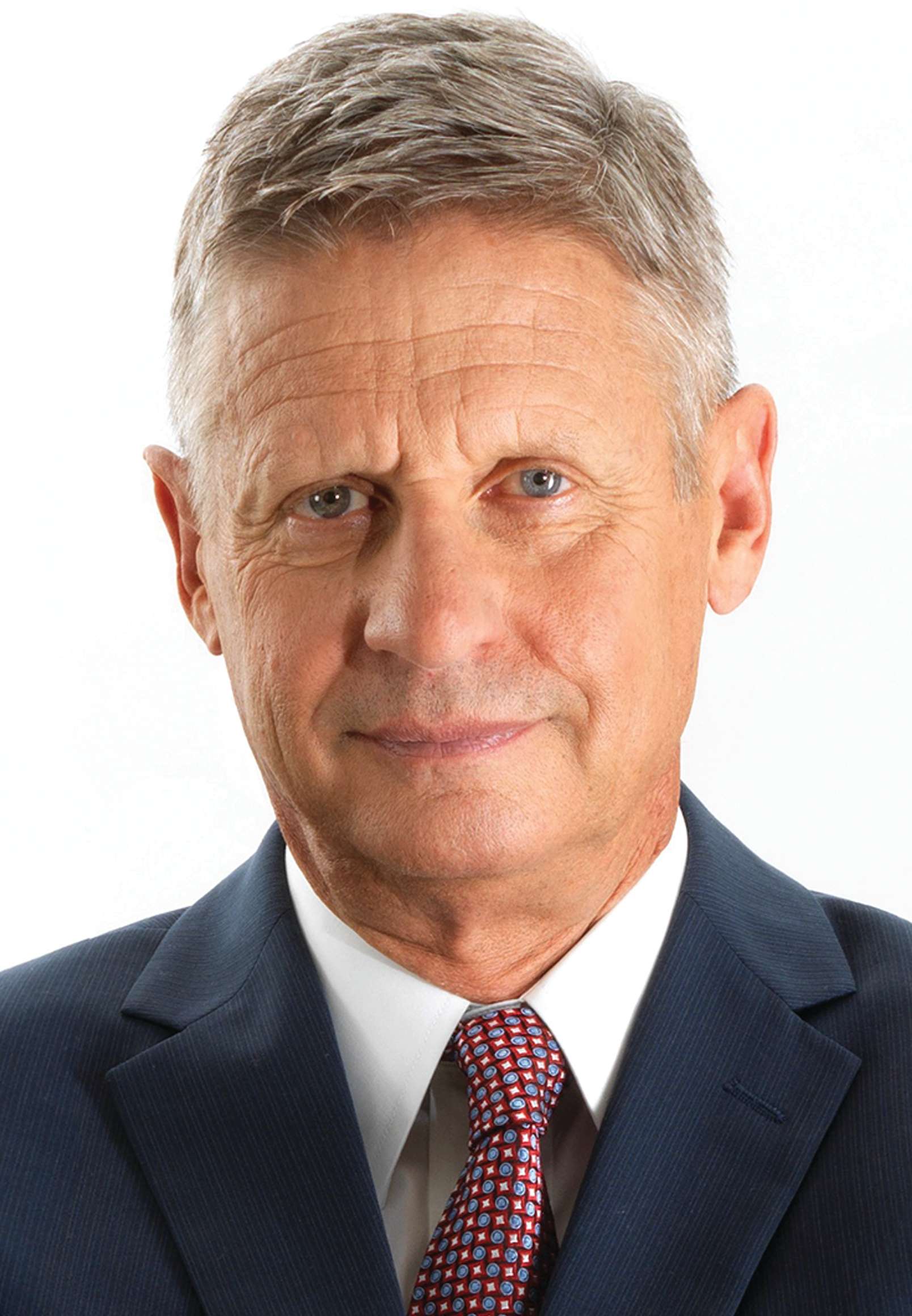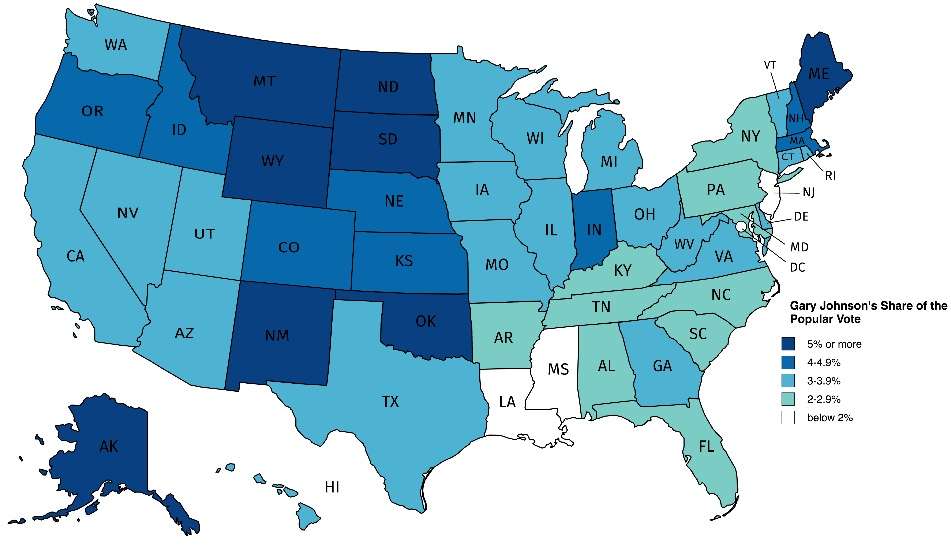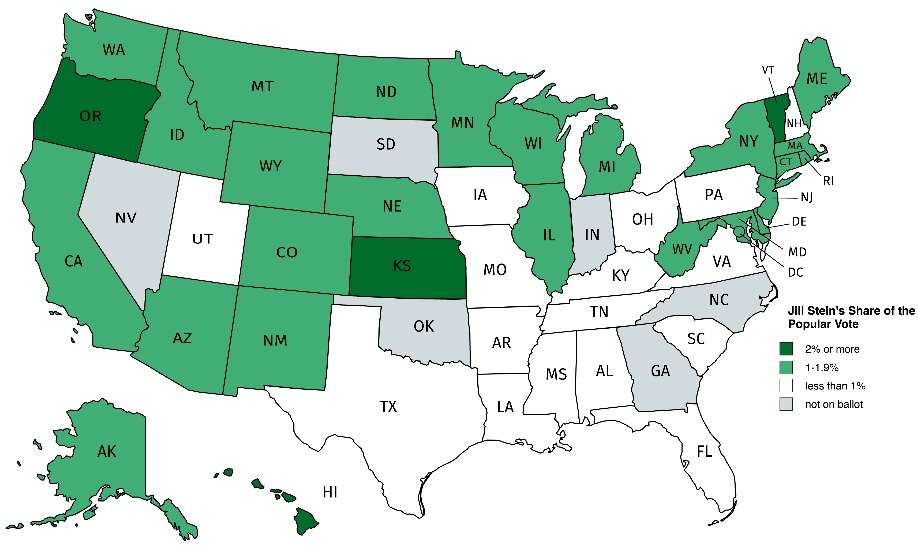Where the Third-Party Candidates Were Strongest
Which states gave Gary Johnson his best results? Jill Stein? Evan McMullin? And who did those candidates help more, Trump or Clinton?


Yesterday's presidential election produced the strongest showing in 20 years for third-party and independent candidates. Not all the ballots have been tallied yet, so some of the numbers below may be slightly off from the final totals. But at this point all the alternative candidates put together have received more than 5 percent of the popular vote. The leader of the second-tier pack, Gary Johnson of the Libertarian Party, has (at this point in the counting) 4,012,871 votes, or 3.23 percent of the national total. That's much less than he was polling a couple months ago, but it's far better than any other presidential result in the party's 45-year history. It's also better than any other alternative candidate since Ross Perot's campaigns of 1992 and '96.
On the state level, we didn't get to see some of the more extraordinary possibilities that had been tossed around before Tuesday. (No, Evan McMullin did not carry Utah.) But the second-tier candidates did do stronger in some places than others, giving us a map—multiple maps—of where our binary party system is doing the poorest job of representing the full spectrum of political opinion. Here's how the third-, fourth-, and fifth-place finishers fared across the country:
Gary Johnson. Not surprisingly, Johnson did best in New Mexico, the state where he was governor from 1995 to 2003: He got 9.3 percent of the vote there (and in some counties hit double digits). He got 5 percent or more in seven other states as well: North Dakota (6.3 percent), traditionally third-party-friendly Alaska (5.9), Oklahoma (5.7), South Dakota (5.6), Montana (5.6), Wyoming (5.3), and Maine (5.1).
He got at least 1 percent of the vote everywhere. His weakest showing was in Mississippi, where just 1.2 percent of the voters backed him. That's still more than double his total there in 2012.

Jill Stein. As I write, Jill Stein of the Green Party has 1,192,344 votes, or about .96 percent of the national total. That's the Greens' best showing since Ralph Nader's campaign in 2000. Stein's highest percentage on the state level came in Hawaii, where she collected 2.9 percent of the ballots. She also managed to top 2 percent in Oregon (2.4 percent), Vermont (2.3), and—more surprisingly—Kansas (2.0). She did not outpoll Johnson in any state.

Evan McMullin. McMullin, a conservative running as an independent, was on the ballot in only 11 states, so it's not surprising that he finished behind Johnson and Stein. (His total currently stands at 443,298 votes nationally, or .36 percent.) But he did very well in one of those states: He was a strong third in his native Utah, collecting 20.9 percent of the vote and finishing second in several counties. He also managed to get 6.9 percent in Idaho, the only other state where he beat Johnson. He didn't get as much as 2 percent anywhere else, though he managed to clear the 1 percent mark in Minnesota (1.8 percent), Virginia (1.6), Arkansas (1.2), Kentucky (1.2), and South Carolina (1.0). It is no coincidence that McMullin did best in the two states with the country's highest Mormon populations.
The only other candidate who managed to get more than 1 percent of the vote in any states was Darrell Castle of the paleoconservative Constitution Party, who is currently pulling 1.3 percent in Alaska, 1.1 percent in South Dakota, and, more surprisingly, 1 percent in Hawaii. In Nevada, where voters have the option of voting for None of the Above, that option pulled 2.6 percent.
Did these candidates tip any states from Clinton to Trump? I've already heard some ruminations to that effect from angry Democrats ready to replay their scripts from 2000, but it's a hard case to make. Johnson initially drew both disaffected Democrats and disaffected Republicans, but toward the end of the race the polls suggested that he was pulling much more from the Trump camp. (Of course, I don't blame you if you don't feel like trusting any polls right now.) And if these three candidates weren't on any ballots, a significant share of their supporters would have simply stayed home rather than vote for Clinton or Trump.
Indeed, a lot of people stayed home anyway. Turnout in general was way down this year, and Trump is currently on track to finish with a lower raw vote total than either Mitt Romney or John McCain. Let me repeat that, just to drive home how unpopular the major-party candidates were this year: The man who won this election got fewer votes than the men who lost the last two elections. Even though the country's population has grown, and even though they both lost pretty badly. [UPDATE, 11/10: This may have been premature, as it was based on a vote count that had been mislabeled as being 99 percent complete. Trump is now closing in on McCain's total and could conceivably surpass Romney. Either way, the underlying point stands: Minor-party voters may well have preferred to stay home rather than choose a major-party nominee.]
All that said, there were several states where the alternative candidates collected enough votes to cover the Clinton/Trump spread. Six of those were won by Trump—and seven were won by Clinton. Here's a rundown:
Arizona: Trump beat Clinton by four points; Johnson and Stein between them collected 5 percent. But most of that went to Johnson (3.8 percent), so it's unclear whether Trump or Clinton was hurt more by the other options on the ballot.
Colorado: Clinton won by 2.2 percent. Voters also gave 4.9 percent to Johnson, 1.2 percent to Stein, 1 percent to McMullin, and nearly 1 percent more to a collection of third-tier candidates. If Johnson was pulling more Republicans than Dems in Colorado, he may have given this one to Clinton.
Florida: Trump eked out a win by just 1.4 percent here. Johnson, Stein, Castle, and Rocky De La Fuente of the Reform Party between them collected 3.2 percent. Enough to cover the spread, but how many of those votes would have otherwise gone to Clinton? Stein got only .7 percent.
Maine: Clinton won this by three percentage points, and Johnson collected 5.1 percent, so there's a chance he tipped the state to the Democrats. (Or part of the state, anyway: Trump carried Maine's second congressional district, so he is being awarded one of the state's electoral votes.)
Michigan: Trump won this ordinarily blue state by about .3 percent, and Stein got 1.1 percent, so Democrats who feel all Green votes are rightfully theirs are going to be seething at her over this one. Meanwhile, Johnson got 3.6 percent.
Minnesota: Clinton won by 1.4 percent. McMullin got 1.8 percent. How many of those voters would have gone for Trump otherwise, and how many would have stayed home? Beats me, but between that and the other minor-candidate results—Johnson got 3.4 percent and Stein got 1.3—this looks like a state where the alternatives may have done more to help Clinton than to hurt her.
Nevada: Clinton won by 2.4 percent; Johnson got 3.3 percent. And Castle picked up half a point too.
New Hampshire: Another narrow Clinton win—just a tenth of a percentage point—and another relatively strong showing for Johnson, who collected 4.1 percent.
New Mexico: Clinton won this handily, by 8.3 percent. But Johnson, remember, got 9.3 percent. Then again, he has a history of picking up Democratic votes in New Mexico—he was reelected easily in his days as governor, despite the predominantly Democratic electorate—so it'd be hard to make the case that he played spoiler.
Pennsylvania: Trump won by about 1.1 percent. Stein's .8 percent isn't enough to cover that spread; Johnson's 2.4 percent is, but again we don't know whether he was drawing more from Trump or Clinton.
Utah: Trump beat Clinton here by about 17 percent. Sounds like a pretty big victory, but it's still less than McMullin's 20.9 percent. In this case you could make the case that the real spoiler was Clinton: If she weren't on the ballot, nearly all of her supporters surely would have preferred McMullin to Trump, perhaps allowing the independent to deny the Republican six electoral votes.
Virginia: Clinton won by 4.7 percent. Johnson, McMullin, and Stein got 3, 1.6, and .7 percent, respectively. So the third-party candidates covered the spread if you include the Green, but the two candidates who were more likely to pull from Trump didn't have quite enough to cover it on their own.
Wisconsin: Here, on the other hand, Stein's 1.1 percent is just enough to bridge the 1-percent margin between the winning Trump and the losing Clinton. But then what does Johnson's 3.4 percent do to the results—or, for that matter, the nearly half a percentage point that Castle won while running to Trump's right?
Damned if I know. I will say this, though: If the Democrats find themselves searching for scapegoats by parsing the Green and Constitution parties' totals rather than asking how they managed to nominate a candidate so weak that Wisconsin was in play, they really aren't asking the right questions.
This post has been updated to account for some late-arriving returns.


Show Comments (113)